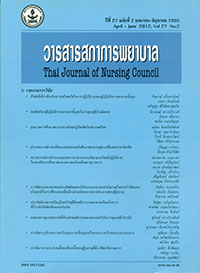การพัฒนาและทดสอบประสิทธิผลของโปรแกรมการออกกำาลังกาย ด้วยการรำาไม้พลองประยุกต์กับการฟ้อนมองเซิงเมืองน่าน ต่อสมรรถภาพทางกายของผู้สูงอายุ
Keywords:
โปรแกรมออกกำลังกายในผู้สูงอายุ, การฟ้อนรำพื้นบ้าน, สมรรถภาพทางกาย, exercise programme, elderly people, traditional dance, physical performanceAbstract
บทคัดย่อ
การวิจัยนี้มีวัตถุประสงค์เพื่อพัฒนาและทดสอบประสิทธิผลของโปรแกรม การออกกำลังกายด้วยการรำไม้พลองประยุกต์กับการฟ้อนมองเซิงเมืองน่านต่อ สมรรถภาพทางกายของผู้สูงอายุ แบ่งเป็น 2 ระยะ คือ 1) ระยะพัฒนาโปรแกรมการออก กำลังกายด้วยการรำไม้พลองประยุกต์กับการฟ้อนมองเซิงเมืองน่าน 2) ระยะทดสอบ ประสิทธิผลของโปรแกรมการออกกำลังกาย โดยทดลองแบบกลุ่มเดียววัดก่อนและหลัง กับกลุ่มตัวอย่าง ผู้สูงอายุหญิง จำนวน 24 คน การเก็บรวบรวมข้อมูล ได้แก่ แบบบันทึกค่า ความสามรถในการใช้ออกซิเจนสูงสุดของร่างกายและแบบบันทึกความยืดหยุ่นของกล้ามเนื้อ และข้อต่อ วิเคราะห์ข้อมูลโดยใช้สถิติค่าเฉลี่ย ส่วนเบี่ยงเบนมาตรฐาน และสถิติทดสอบ ค่าทีสองกลุ่มสัมพันธ์กัน
ผลการวิจัยพบว่า โปรแกรมการออกกำลังกายด้วยการรำไม้พลองประยุกต์กับการ ฟ้อนมองเซิงเมืองน่าน มีการออกแบบท่าทางได้เหมาะสมกับผู้สูงอายุที่สามารถออกกำลังกาย ได้ทุกส่วนของร่างกาย ประกอบด้วย 3 ช่วง ได้แก่ ช่วงอบอุ่นร่างกาย 10 ท่า ช่วงออกกำลังกาย 18 ท่า และช่วงผ่อนคลาย 10 ท่า ใช้เวลาทั้งหมด 43 นาที ผู้ทรงคุณวุฒิประเมินความเหมาะสม ขององค์ประกอบด้านต่างๆ ของการออกกำลังกายที่ระดับมากถึงมากที่สุด รูปแบบการ ออกกำลังกายนี้มีความเที่ยง และมีความหนักอยู่ในระดับปานกลาง ผลการทดสอบประสิทธิผล ของโปรแกรมการออกกำลังกายในผู้สูงอายุหญิง จำนวน 24 คน เป็นระยะเวลา 12 สัปดาห์ พบว่าสมรรถภาพทางกายด้านความยืดหยุ่นของกล้ามเนื้อและข้อต่อ และด้านความทนทาน ของปอดและหัวใจของผู้สูงอายุ มีค่าเพิ่มขึ้นอย่างมี นัยสำคัญทางสถิติที่ระดับ 0.001
ผลการศึกษานี้ชี้ให้เห็นว่าโปรแกรมการออกกำลังกายที่ประยุกต์ใช้การฟ้อนรำพื้นบ้าน เป็นฐานมีความเหมาะสมกับผู้สูงอายุ และสามารถนำมาใช้เป็นทางเลือกหนึ่งในการส่งเสริม การออกกำลังกายในผู้สูงอายุได้
คำสำคัญ : โปรแกรมออกกำลังกายในผู้สูงอายุ, การฟ้อนรำพื้นบ้าน, สมรรถภาพทางกาย
Abstract
The main objectives of this research study were to develop an exercise programme which applied wooden clubs to the traditional ‘Mong Serng’ dance of Nan Province, and to test its effectiveness and impact on elderly people’s physical performance. This study was conducted in two phases. In Phase One, an exercise programme with an application of wooden clubs to the traditional ‘Mong Serng’ dance of Nan was developed. In Phase Two, the programme’s effectiveness was tested. The test was administered to all of the sample subjects, a total of 24 elderly females, both before and after the trial of the programme. The data were collected through (a) the Maximum Oxygen Intake Recording Form and (b) the Arthro-Muscular Flexility Recording Form. The data were statistically analysed according to their mean, standard deviation and paired T-test.
The study showed that the exercise programme which applied wooden clubs to the traditional ‘Mong Serng’ dance of Nan Province required physical movements that enable elderly people to properly exercise every part of the body. The exercise programme, which lasted 43 minutes, consisted of three parts: 10 warm-up activities; 18 exercise activities; and 10 cool-down activities. All of the elements of this exercise programme were assessed by the appointed experts, who rated them ‘high’ to ‘highest’, whilst its accuracy and strenuousness were rated ‘moderate’. The effectiveness test of this programme, which was administered to the 24 elderly females for a period of 12 weeks, revealed a statistically significant increase (0.001) in the subjects’ arthro-muscular flexility and cardio-pulmonary strength.
The results showed that exercise programmes incorporating traditional dance patterns could be suitable for elderly people, either as a main or alternative programme to promote exercise amongst elderly people.
Keywords : exercise programme, elderly people, traditional dance, physical performance








